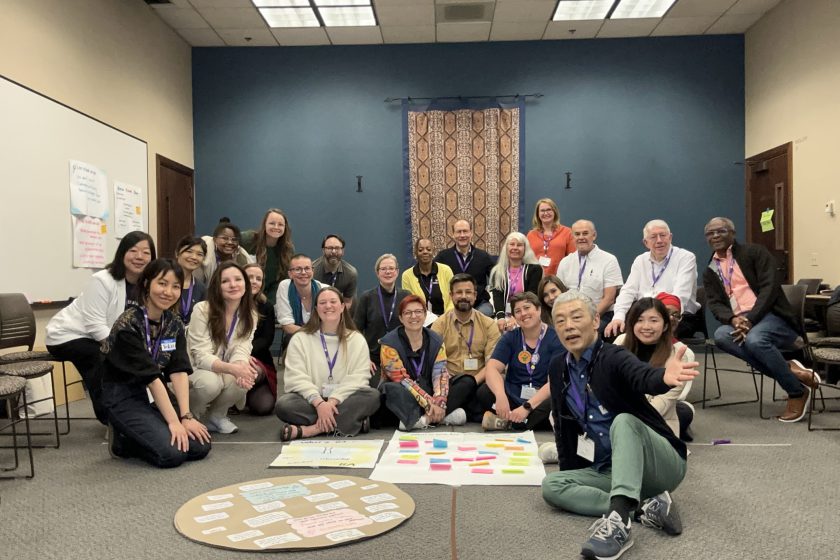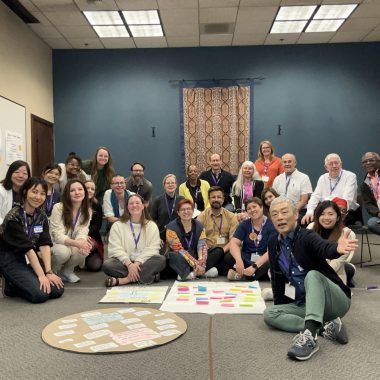This post is also written in the following language:
![]() 日本語 (Japanese)
日本語 (Japanese)
In April 2024, the international facilitator’s conference, IAF Conference of Americas was held at San Diego, California. And Hideyuki Yoshioka, CEO of Knowledge Signs conducted the original workshop of the topic of “Silence”
IAF(The International Association of Facilitators) is the international association of facilitators which enlists thousands of affiliates of facilitators across the world. It has 6 regional chapters as Asia, North America, South America, Eu, Oceania, Africa and annual regional conference is held almost every year.
Hideyuki Yoshioka(CEO of Knowledge Signs) and associate global facilitator, Yuko Gendo facilitated the session. The title is The Art of Silence “Adapting Japanese wisdom to facilitation of tomorrow’s world”, which underscores the value of Silence.
Silence is generally believed to be negative situation in facilitation. And also it often occurs in Japanese dominated group. Many facilitators try to craft the ways to break the silence.
But, we highlighted unknown positive aspects of silence. Basic concept of this workshop is, “Silence is creative, productive and interactive.”
You can also refer to the video of the workshop.
https://www.youtube.com/watch?v=zFgixJLUHNE
Process to look through Silence
We suggest to use different lenses to look through Silence. At the first step, participants try to perceive Silence by using facilitator’s lens and participant’s lens.
When we face the silence as facilitators, we tend to think “Silence is not good situation.”, “How can we break the silence?”. Meanwhile, when we face the silence as participants, we have certain reasons for us to be silent.
In the first group activity of the workshop, participants reflected how they were thinking when they face the silence as facilitators and participants as well. It brought a lot of awareness.

And then, we suggested to use a lens to look inside and a lens to look outside. A lens to look inside highlights our inner self, how we feel, how we think. A lens to look outside highlights outside environment, group of people, individuals, relationship, topic, process or physical environment.
Prior to this workshop, we’ve run some trial session in Japan. And we noticed many people pay attention to outside rather than inside when they face the silence. It might be Japanese cultural trait. In Japan, we always value harmony with the group we belong to. And we regard we are part of outside environment. Sometimes we call outside environment “BA(場)”.Ba can be translated as space, place but it’s more holistic concept.

This attention for outside encourages us to contribute BA, outside as, “How can I make the group more interactive?”, “How can I make the discussion more creative?”, “What can I do for BA?”.
That psychological effect shows a positive aspect of Silence.
And we came up with the hypothesis as “When we face the silence, firstly a lens to look inside works and then a lens to look outside tarts to work.” This switching process from inside to outside is very important, If the time of Silence is not sufficient, if the silence is broken early, we might lose a chance to use these two lenses, we might lose a chance to be more creative and more interactive to BA.
We used to believe “Silence could happen any time but it should be short.” But our suggestion is, “Silence should be long enough so that interaction can spontaneously come out.”

What we suggested how to address to Silence is,
‣Accept Silence (If any, invoke Silence)
‣Adapt the gift of Silence
When Silence happens, A lens to look inside and outside make us aware of a lot of things. Self-awareness, Observation, Assumption, Intention for BA. We regard them as gifts of silence. Something which encourages the participants to contribute BA interactively.
Facilitators try to many ways to make the group more creative, interactive and productive on their own. But sometimes Silence helps facilitators by encouraging the participants to contribute BA.We should adapt those gifts.
In this workshop, we intentionally let the participants have 2-minute silence and reflect on what they noticed about BA, what they noticed as the gift of Silence.
And they thought how they want a facilitator adapt them by using participant’s lenses. Because what the participants want a facilitator is what a facilitator should do.
These are learning outcomes of the participants

The Art of Co-Facilitation
What a facilitator needs to do for the workshop is basically following two stuffs.
‣Design the workshop process
‣Deliver the facilitation
This time I associated with a co-facilitator, Yuko Gendo and we decided to show a good example of co-facilitation.
The simplest way of co-facilitation is relay style. Facilitator A undertakes the first part, and facilitator B does the second part. It’s efficient for facilitators, but we don’t think it maximizes the value of co-facilitation.
What we intended to intensify in our co-facilitation are;
‣Two facilitators fully take the equal part
‣Interaction of two facilitators brings more engagement and more value
‣We encourage spontaneous mind-shift by well designed Story-telling
And then we came up with conversation skit role playing style. It goes like a theatrical play. Two characters play the role having conversation. Along with the lines each character articulates, story is developing.
I decided two characters as, Yuko acts a character who believes the positive aspect of Silence and rigid theory of how to adapt Silence, Hideyuki acts a character who doesn’t like Silence and regard the silence as unproductive. They are polarized characters. But Hideyuki would be influenced by Yuko and gradually changes his mind and eventually turns out to be positive about Silence.
As you see, Hideyuki’s character represents participant’s general notion about Silence. Participants would experience of mind-shift as Hideyuki does by following the story, following how Hideyuki changes, overlapping Hideyuki’s felling, That’s the remarkable effect of theatrical story-telling approach.


Magic of special tools brings more engagement
In in-person workshop, physical tools works very importantly. We display various flip charts which help the participants understand the process and methods visually. Many of participants are really attracted by them. Visual tools bring more engagement.
Particularly, cardboard table top called “Enat-kun” (Japanese product) really attracts the participants. It’s simple and very convenient tools. We can put it on our knees and use as a table as below,




We must embrace our cultural nature
In this workshop, we have another intention to achieve, “How we can make people change their notion based on cultural pre-conception.” When Japanese facilitators join international conference events, we often see many Japanese participants don’t speak up actively and tend to be quiet. We must admit that’s our cultural trait.
Some non-Japanese facilitators explicitly point out that’s our weakness and to be improved. I partially agree on that. But, being silence is not an issue. It’s just a phenomena.
Nevertheless, that kind of observation prompts Japanese to try to change the way we behave. Changing is positive. But sometimes the effort to change looks denying our cultural nature.
I believe no one who denies own cultural nature can achieve to make a presence in global situation.
So we dared to choose the challenging topic of “Silence” which most of people regard as negative by encouraging the mind shit.
At the end of the day, our ambitious plot turned out to be the huge accomplishment. We really appreciate all people who get involved in this project.
Hideyuki Yoshioka
Facilitators
- Hideyuki Yoshioka CEO of Knowledge Signs Inc.
 As a professional facilitator, Hideyuki has crafted unique methods of facilitation and consulting. Hideyuki has been involved in professional facilitation for over 20 years and facilitated almost a thousand times of meeting.
As a professional facilitator, Hideyuki has crafted unique methods of facilitation and consulting. Hideyuki has been involved in professional facilitation for over 20 years and facilitated almost a thousand times of meeting.
Hideyuki always commits very critical meetings that require critical outcomes as enterprise mid-term strategies, organizational development plan, digital transformation plan.
And also has plenty of experiences to facilitate cross cultural group.
Hideyuki is always influential to facilitator’s community in Japan as a spearhead to lead new challenges.
Hideyuki has conducted original workshops in IAF Asia conference for three years in a row since 2014.
■Certification
IAF CPF(Certified™ Professional Facilitator)
Language: Japanese, English
Available: Japan, Singapore, Hong Kong, India,other areas in Asia, North America, Eu
Yuko Gendo Dialogue Facilitator
 Yuko is a professional facilitator, workshop designer and coach based in Kanagawa, Japan. She has 10 years’ experiences in facilitating managing teams, designing leadership programs, and delivering organization development programs during her business professional in 18 years.
Yuko is a professional facilitator, workshop designer and coach based in Kanagawa, Japan. She has 10 years’ experiences in facilitating managing teams, designing leadership programs, and delivering organization development programs during her business professional in 18 years.
Yuko specializes in designing impactful workshop s such as milestone corporate meetings and dialogues that bring together a diverse group of citizens to deal with local issues. Leveraging her experience in the IT industry, she has conducted numerous innovative practices especially in online workshops in Japan.
As part of her involvement with the International Association of Facilitators (IAF), she earned the Certified Professional Facilitator (CPF) designation in 2018 and serve as a board member for the Japan chapter to be at the forefront of leading activities. She actively contributes to the facilitation community in Japan, advocating them to look beyond their local context and engage with the global facilitation community.
As her grandparents were hibakusha (atomic bomb survivors), she has a profound passion for fostering understanding people in different countries.
■Certification
IAF CPF(Certified™ Professional Facilitator)
Language: Japanese, English
Available: Japan, Singapore, Hong Kong, India,other areas in Asia, North America, Eu


















